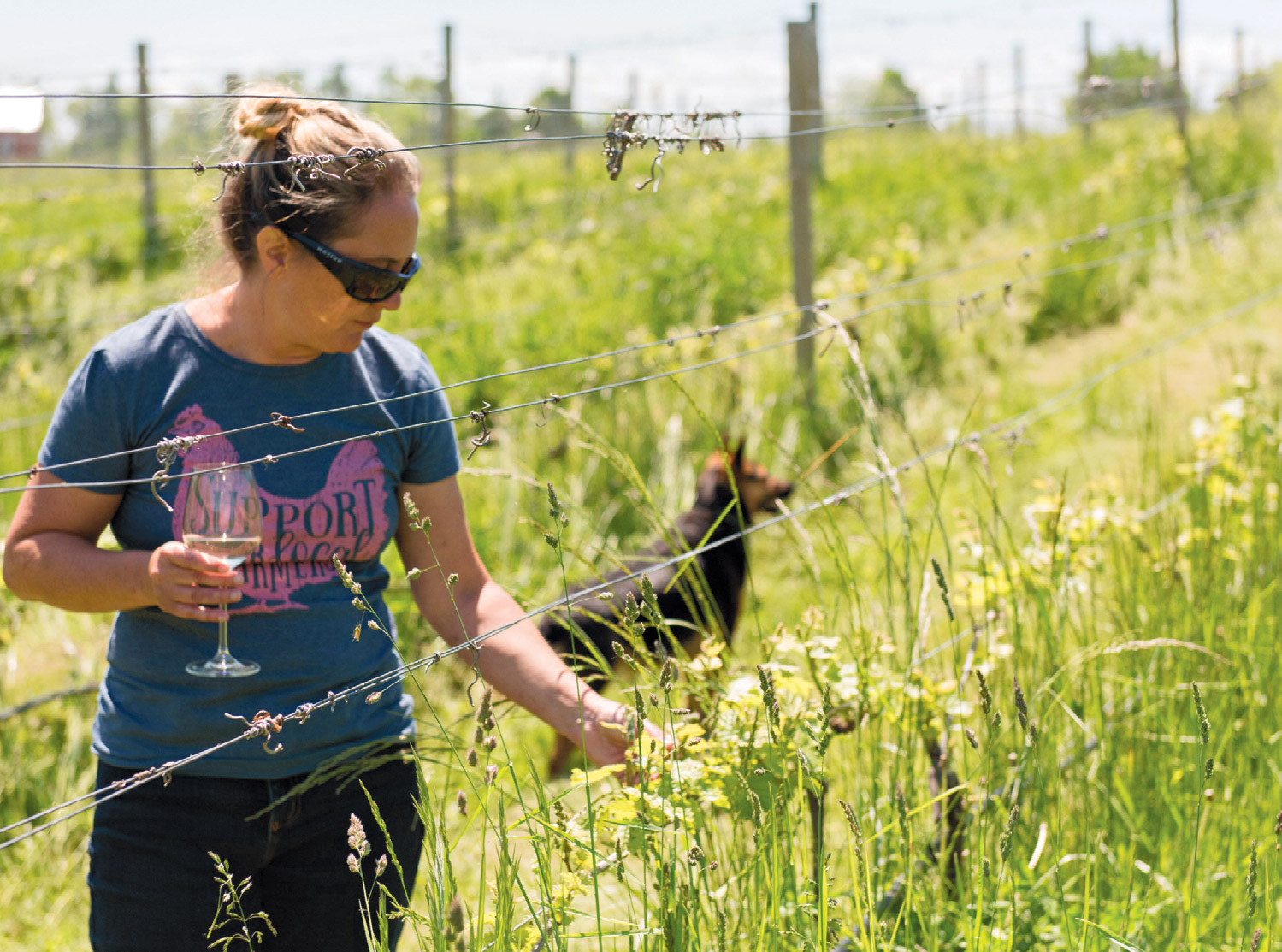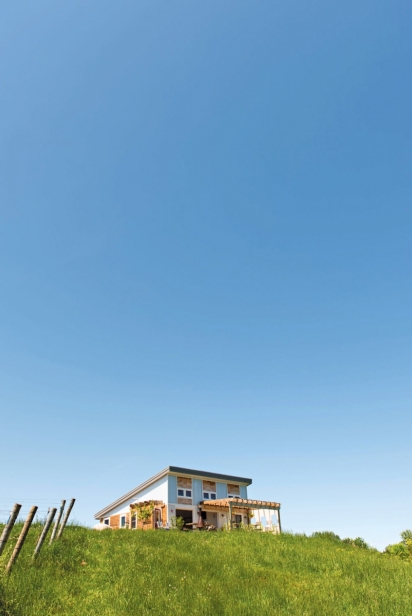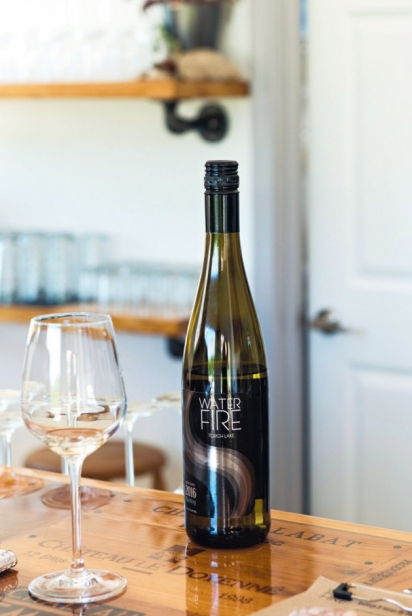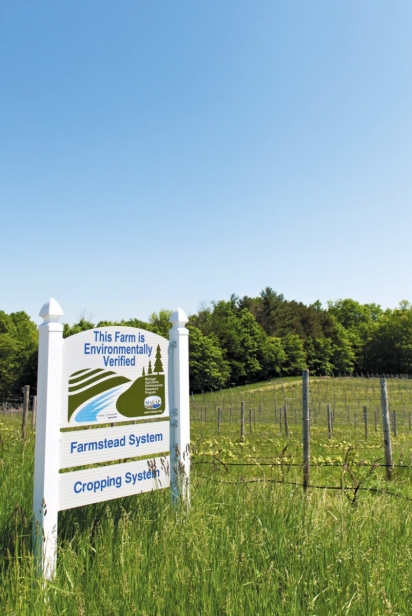Love of Wine and Water
Surprises abound at WaterFire Vineyards, a boutique winery that sits north of Elk Rapids, about a mile east of US-31, near the shores of Lake Michigan and the moderating bays of Traverse City that have been instrumental in helping winemakers along Old Mission and Leelanau Peninsulas succeed in growing vinifera, grape varieties most wine drinkers are familiar with: Riesling, Chardonnay, Merlot and Pinot Noir, to name a few.
The views from the modest tasting room at WaterFire Vineyards are idyllic: sloping vines, thick woods and expansive fields. While the growing conditions here, nearly 30 miles northeast of Traverse City, can be slightly harsher, owner Chantal Lefebvre’s nine acres of Riesling, Sauvignon Blanc and Grüner Veltliner have done well. It’s a combination of the property’s higher elevation— 850 feet—and being sandwiched between Lake Michigan and Torch Lake, Michigan’s largest inland lake, about a half mile to the east.
Lefebvre and her husband, Michael Newman, bought the 26-acre farm in 2008 after ruling out properties on Old Mission and Leelanau Peninsulas because of higher real estate prices. The purchase was serendipitous; they found the location after their real estate broker heard about it during a game of bridge with friends. The former cherry orchard, hilly, with good air drainage, also contained the right soil conditions— sandy loam—ideal for growing wine grapes. Typically, where cherries thrive, so do the grapes.
“We were looking for property that was suitable for cherry orchards, knowing they would be equally suitable for grapes,” Lefebvre recalls. “This site was ideal. We knew the grapes could thrive here, so we snapped it up.”
Her first vines were strategically planted in 2009 and 2010, and WaterFire produced its first vintage in 2012, after harvesting Sauvignon Blanc and Riesling, grapes typically not associated with viticulture along the open coastal stretch northeast of Traverse City. Lefebvre initially bottled her Sauvignon Blanc and sold her Riesling crop to Left Foot Charley, an urban winery in Traverse City where she learned vineyard skills and a few things about making wine.
“She is about as far north as Riesling is going to grow, at the outer limits of the region for vinifera and the impact of the bay,” says Bryan Ulbrich, winemaker at Left Foot Charley and Lefebvre’s mentor. “She’s still getting influence from the water and snowfall for coverage in the winter. From there, the influence of the bay starts to go away and becomes more like Lake Michigan.”
The only pause Lefebvre had about the farm, nestled amid the expansive cherry orchards that hug US-31, was the distance from other vintners and well-traveled wine trails: Old Mission and Leelanau to the south, and the Petoskey Wine Region to the north.
“We were so far from everyone else,” she recalls. “We were among the first vineyards planted here and I wondered if people would come.”
PRACTICING SUSTAINABILITY
Northern Michigan’s unpredictable weather is enough for any vintner to battle, but Lefebvre has pursued a road far less traveled in the wine industry. She has embraced sustainable farming practices, eschewing conventional chemicals to cultivate her vines. Instead, she uses biological fungicides.
“We have conditioned our vines to use their own immune systems,” she explains. “We’re not doing all the work for the grapes. We’re helping them be healthy. Our game plan is build healthy soil and minimize the impact on the good guys that are there to help us. If you use a broad spectrum insecticide, for example, you kill a lot of good guys, including bees and other insects that can be helpful in the vineyard.”
WaterFire Vineyards is Certified Sustainable, through the Sustainability in Practice program, the first and only one in Michigan and the Midwest to achieve that recognition and, for that matter, the first outside California.
Sustainability in Practice goes beyond simply growing organic produce. It’s a whole-farm approach that encompasses the entire operation: how much water is used and how effectively; how much energy is used in the operation. All farming practices are documented and verified by independent audit. Additionally, certification looks at how much education the owner is receiving and providing for employees, how well employees are compensated, land conservation efforts and the maintenance of habitat for pollinators.
“Being organic is only part of the picture,” Lefebvre says. “You can buy products that are organic that still wreak havoc on the environment. We make choices that don’t. We are making choices in terms of wine quality and to the benefit of everything we have living around here.”
The decision to become a sustainable vineyard stems from Lefebvre’s educational and career background in environmental science and oceanography.
“I did a lot of work related to coastal pollution and trying to stem the tide of coastal pollution,” says Lefebvre, a former coastal science and policy specialist at the University of Massachusetts. “The agriculture industry is one of the biggest sources of pollution in the ocean and ranks high in the Great Lakes, too. What’s happening here is not the same scale as what’s happening in the Chesapeake Bay or the Gulf of Mexico or the Mississippi River but it’s a concern.
“Certain chemicals used in agriculture can be very persistent, eventually making their way into the watershed and lakes,” she points out. “We are surrounded by gorgeous lakes. We don’t want to have chemicals on our property end up in our watershed. From the beginning, we were determined to be sustainable.
Those daily sustainable farming practices might not be noticeable to visitors, but there are tangible results, evident in every glass of wine poured in the tasting room.
“The quality of our wine is very high,” Lefebvre says proudly. “I think we tend to have richer wines. They lend themselves to a richer mid-palate that is very unique. It’s a richness you don’t find as frequently in colder climates.”
The richness and complexity in the glass is a direct result of her farming practices, Lefebvre says. “We avoid a chemical approach that does all the work for the vines because we want the vines to react appropriately to stresses like pests, disease and cold. The plants’ immune responses create alkaloids, terpenes, phenolics, tannins, saponins, all these complex molecules that go into making the best wine possible. It’s a work in progress, and we are always learning about how best to achieve this goal.”
That less-traveled approach also allows visitors to explore WaterFire’s vineyards without the concerns of the lingering residue of chemicals after spraying— hazards that require other winemakers to limit or bar access at times.
WINES AND TASTING ROOM
Housed in a modern, minimalist building, WaterFire’s tasting room is small but inviting. The bar, made from old wine crates with the names of wineries on them, was constructed by Lefebvre’s husband. A few stools hug the bar; guests are encouraged to sit at a table to enjoy a tasting or glass of wine.
Glass-paneled garage doors open to a patio and those pastoral views of the hilly landscape, giving guests a real sense of being in the vineyard. Rows of vines of Sauvignon Blanc ripple along a hillside north of the tasting room; Grüner Veltliner rests east, with Riesling planted just beyond. The family’s modern-style barn, with its cedar siding and metal roof, and home are visible in the distance.
“What sets us apart is that people are not corralled at the bar,” says Ellis McQuillan, WaterFire’s retail sales manager, who lives nearby. “We offer table service. Our service is very personalized. We encourage people to buy a glass of wine and walk in the vineyard. We’re a pretty family-friendly and dog-friendly place.”
It is through Lefebvre’s dog, Finley, a mix of Australian herding breeds, that McQuillan became acquainted with Lefebvre. McQuillan was Finley’s teacher at puppy kindergarten, then joined WaterFire as a field hand in 2016 and still works in the vineyard and helps with the harvest.
The tasting menu, though limited to just three white varietals and one red plus a hard cider, is no less interesting than those at wineries offering broader selections. Tastings are $6.50.
Among the wines is a 2016 Grüner Veltliner, a white varietal native to Austria and not as familiar to many as other white grapes. With its bright citrus fruit and pepper flavors, Grüner has long been one of Lefebvre’s favorites, a grape she knew she was going to grow.
Gneiss (pronounced “nice”) Blanc is a blend of Sauvignon Blanc, Traminette and Riesling. The Traminette is purchased from a grower on Old Mission Peninsula; the other grapes are estate grown. The blend’s name comes from the gneiss rock boulder unearthed while they were ripping the fields to plant vines. The rock now sits outside the tasting room.
The hard cider is made with wild apples harvested from nearby farms. Domestic apples—Baldwin, Pink Lady and Ruby Jon—have also been blended in. A few wild apple trees remain on Lefebvre’s farm, visible from the tasting room, and those apples are used as well.
“Wild apples are fun to pick. They’re ideal for hard cider. They’re small and can be quite bitter or tart,” Lefebvre says.
The only red wine on the menu is a 2013 Pinot Noir. The grapes are not grown locally but are purchased from a vintner in Oregon who adheres to sustainable farming practices. Lefebvre has labeled the bottle Nine Below Zero, a reference to the point at which temperature can kill the primary bud, sometimes even the secondary bud, and do serious damage to the vines. Finley is illustrated howling on the label.
“Though the tide is shifting, there’s a lingering stigma attached to Michigan reds, but even more so they can be challenging to ripen. But we wanted to have a red to offer,” she says, “to accommodate the strictly red wine drinkers.”
UNLIKELY WINEMAKER
Lefebvre, 48, who grew up in Alberta, Canada, is unusual among winemakers and vineyard owners in Michigan.
While there are a handful of female winemakers across the state, there are fewer women who own and manage vineyards. WaterFire also boasts an all-female crew, helping maintain the vineyard and staffing the tasting room.
While she pursued another career focus earlier in life, her passion for wine and a relocation to northwestern Michigan cemented her current vocation.
“I was just a drinker,” she says, reflecting on her past. “My parents imparted a lot of wine knowledge to me growing up. I would also read wine magazines and developed a vocabulary for wine but that’s about it.”
She and her husband moved to Michigan, following in the footsteps of her parents. The family fell in love with the region and determined it was better suited to raising their child, Nate, 14, than living in the city.
They relocated to Traverse City from Boston with no particular plans. Newman found a job almost immediately. Lefebvre started working in the wine industry, initially in the tasting room at Bowers Harbor Vineyards on Old Mission Peninsula, where Ulbrich was then the winemaker. She followed Ulbrich to Left Foot Charley, working in the tasting room, helping in the cellar, and in the vineyard before harvest.
“I was smitten by the vineyard side of things. The scientific side of growing meshed well with my background,” she says. “It was easy for me to learn about and understand soil chemistry, how to build healthy soil. I keep up with the latest science and products and that’s what helped with being certified sustainable.”
FUTURE
A decade after planting those first vines, WaterFire is firmly rooted in Antrim County, drawing a growing number of visitors each year. Some of her wines are poured in regional restaurants, including Cooks’ House and Trattoria Stella in Traverse City, the Inn at Bay Harbor, Cellar 152, Siren Hall and the Garden Café at Pine Hill Nursery.
The winery, too, now finds itself on a newly created trail, The Torch Lake Tour, a collection of wineries, cideries, craft breweries, meaderies and distilleries situated around the waters of Torch Lake.
“We’ve grown every year since we opened,” Lefebvre says. “This year is no exception. Despite the disappointing weather, business has been good.”
Left Foot Charley’s Ulbrich is not surprised at WaterFire’s success.
“It’s been a pleasure to watch things grow over there and see the expansion of the wine industry in that direction,” he says. “She’s working hard to establish a new region and it’s encouraging to see. It’s going to be fun to watch the direction she goes from here.”
Looking to the future, Lefebvre hopes to increase production beyond the 150 to 600 cases a year she now produces, to about 1,200 cases. She’d also like to focus retail sales on the premises and not worry about distribution.
“We’d like to build a loyal following here,” she says.
Reflecting on her own farm practices, she’d like to see customers—and other growers—become more interested in sustainable methods. Some customers express curiosity about her operations but interest from the agricultural community has been minimal.
“I’d like people to be more open to sustainable farming, not just for grapes. It’s my hope that people will try to be a little less impactful and better stewards of the environment by shrinking their footprint. Sustainable practices have so much to offer to all of us.”








